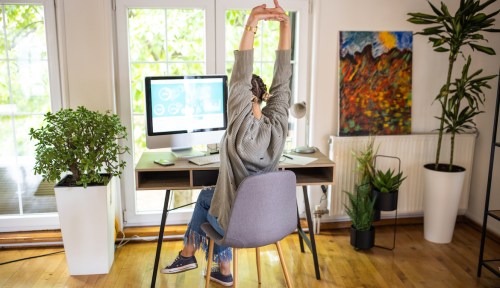5 Back Mobility Exercises That Offer Immediate Relief, According to a Trainer
These 5 back mobility exercises will help your spine move freely and easily again after a day spent hunched over the computer.

Working from home comes with its perks: You can sleep in, make a home-cooked lunch, and avoid awkward water-cooler conversations with that annoying coworker. It has its downfalls, too, though. Namely, since working from home became the norm, people everywhere have been sitting even more than they used to in the office, and often with worse posture. I, for one, know that I spent a year and a half working from my couch, which while cozy, was far from stellar for my back. Even now that I’ve prioritized working from my office, in an actual chair, my lower back, hips, and upper right shoulder are still in knots. According to certified personal trainer Bianca Vesco (AKA Coach B), a lack of back mobility is likely to blame.
Experts in This Article
Nashville-based certified personal trainer and fitness instructor
Mobility is defined as “the ability to move or be moved freely and easily.” When we’re talking about back mobility in particular, the more the facet joints in the spine are able to move, the smoother your daily motions will be. The reason? Your spine is the literal backbone of your body, and as such, it impacts literally every bodily movement. “It holds and supports everything you’ve got,” Vesco says. “Having a healthy and mobile spine is crucial because the spine controls the body’s vital functions, provides structural support, and assists us to move through our everyday tasks.”
But thanks to our 9-to-5 (or longer) culture, most of us spend ungodly amounts of time hunched over our desks, neglecting our spines in the process. “The more we sit, the tighter we become,” Vesco says. “We also tend to carry a lot of tension in our spines making it that much harder to move smoothly in our day-to-day lives.”
Thankfully, back mobility exercises can help release that tension. “They help us move and lower our chances for unwanted injury and pain,” Vesco adds.
Five exercises for optimal back mobility
1. Cat-cow
There’s a reason why this movement is given in so many fitness classes—it makes for a nimble spine. “Starting in a quadruped position—hands stacked under your shoulders, knees directly under your hips, neutral spine with your gaze toward the floor—slowly curl your tailbone up toward the ceiling as you inhale and continue to ripple up the spine until your chest is open, your gaze is toward the ceiling, with your head being the last thing to look up,” Vesco instructs. “Reverse the order as you exhale, dropping your chin to your chest, rounding through the spine as you push the floor away, shoulder blades pushing apart.” Repeat this for as long as feels necessary, but ideally for at least 10 reps.
2. Rolling plank
Remember: Back mobility is all about being able to move freely. As such, slow, steady movements are a must for a healthy back. That’s why Vesco suggests adding rolling planks to your routine. “Start in a downward dog, inhale as you ripple your spine one vertebra at a time forward into a plank (or more advanced can roll all the way through to an upward facing dog),” she says. “Then, slowly shift your hips back up from plank into downward dog.” Repeat for at least 10 reps, making sure to move slowly in the process.
3. Kneeling T-spine rotation
Love the sensation of your back letting go of tension? You’ll quickly feel it with this simple exercise. “Start in a quadruped position, with your hands stacked under your shoulders, knees under your hips,” Vesco says. “Reach your left arm toward the ceiling as you open your chest to the left side, bring your hand to your left ear with a bent elbow and curl your left elbow toward your right wrist on the floor.” Perform 10 reps on each side.
4. Scorpion stretch
Let it be known: There’s a very good chance your back will crack during this exercise. (I just did it while taking a break from writing this and, my god—it’s so good.) “Start laying on your belly face down, legs straight, with the tops of your feet on the floor,” Vesco says. “Bring your right palm on the floor under your right shoulder and extend your left arm out to a T shape on the left side of your body. Bend your right knee to bring your foot as close to your right bum as possible and begin to twist, leading with the right foot to tap the floor on the outside of the left leg.” Once twisted backward with your foot touching the floor, hold the pose and take three deep breaths before returning to your belly and repeating on the other side. Repeat until you feel noticeable relief in your back.
5. Supine twist
Prefer to lay face up? Vesco recommends a supine twist. “Start laying on your back with your left leg extended long, bend your right knee into your chest and cross it over your midline to the left with your arms in a T-shape, looking to the right,” she says. Hold for a few deep breaths before repeating on the other side. Typically one to five slow reps will offer immediate relief to the lower back.
And remember: Go slow and steady
Whatever you do, don’t rush through these movements. “The slower you move through these back mobility exercises, the more beneficial they will be,” Vesco says. “Using momentum or trying to power through will do more harm than help, so my biggest advice is to go slow, meet yourself where you are, and don’t try to force anything.”
Sign Up for Our Daily Newsletter
Get all the latest in wellness, trends, food, fitness, beauty, and more delivered right to your inbox.
Got it, you've been added to our email list.










